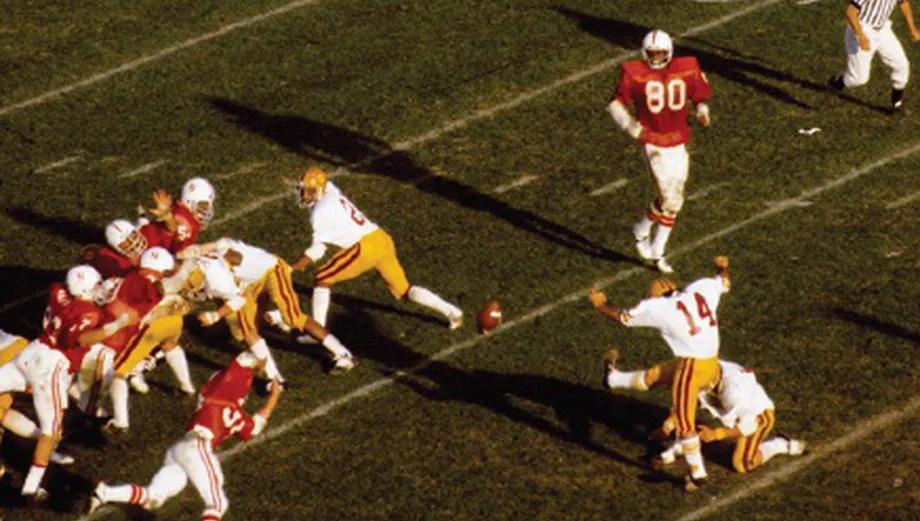•
Written By
Written By
•
•
•
Loading article...
Written By
Written By
On New Year's Day, the Fiesta Bowl will once again play the role of college football's great proving ground for underdogs when Liberty plays Oregon.
Written By
Omar-Rashon Borja
Senior Writer, Editor, Historian
Written By
Omar-Rashon Borja
Senior Writer, Editor, Historian

Before Boise State pulled out every trick in the book against Oklahoma in the 2007 Fiesta Bowl, or Utah became the first BCS buster, or TCU and Boise State faced off because the Power Conferences were scared of being embarrassed, the Fiesta Bowl was a proving ground for underdogs.
The bowl owes its existence to underdogs. The Western Athletic Conference (WAC) saw its champions snubbed by bowls in 1968 and 1969. In 1970, all the big ticket bowls passed on their champ, the #8-ranked Arizona State Sun Devils, forcing them to settle for the Peach Bowl. The WAC then did what any logical conference would do: start its own bowl.
The conference would send its champion to Tempe, Arizona's Sun Devil Stadium to face an at-large opponent in the newly-created Fiesta Bowl.
Arizona State seamlessly dispatched Florida State, Missouri, and Pittsburgh in the bowl's first three years.
The fourth edition saw a school make its first appearance and its decade-long ascent to becoming the only non-Power Conference national champion in the AP Poll era. BYU capped its first WAC championship with its first bowl berth in the 1974 Fiesta Bowl. LaVell Edwards' Cougars lost to Oklahoma State, but BYU had arrived. The Fiesta Bowl had helped schools establish themselves on the national stage, but the game was little more than an afterthought to the Big Four bowls. In 1975, everything would change.
Four years removed from Johnny Rodgers' iconic Thanksgiving Day punt return in 1971, mighty 10-1 Nebraska marched down to Arizona for its consolation prize after losing the 1975 Big Eight title to Oklahoma. The Cornhuskers were the first ranked team outside of the WAC to play in the Fiesta Bowl, boasting the #6 spot in the AP Poll.
The Fiesta Bowl was finally a marquee matchup on the bowl schedule. Naturally, the national media favored the Cornhuskers, making them two-touchdown favorites over undefeated and #7-ranked WAC champions Arizona State. The ensuing Fiesta Bowl would cement the Fiesta Bowl and Arizona State's place in the college football landscape.
Arizona State fought back from a 14-6 deficit to win on Danny Kush's 29-yard field goal in the fourth quarter for a 17-14 win. The Sun Devils rose to #2 in the AP Poll, and the Fiesta Bowl became a tentpole event on the college football calendar. Arizona State moved to the PAC-8 with their archrival Arizona to make it the PAC-10 three years later. The Fiesta Bowl continued its rise, culminating in hosting the National Championship in the 1987 edition when #1 Miami played #2 Penn State.
Decades later, Utah and Boise State continued the Fiesta Bowl's reputation as a proving ground for underdogs. The Utes capped a dominant 2004 undefeated campaign in the Mountain West with the first appearance for a non-Power conference or Big East school in a Bowl Championship Series bowl game (BCS). Utah did not disappoint, dismantling Big East champion Pitt 35-7.
Two years later, the 12-0 WAC champion Boise State Broncos followed in Utah's footsteps and beat Oklahoma in arguably the most thrilling college football game ever. The showcase of underdogs did not end with Boise State. TCU appeared in 2009 alongside Boise State. The Broncos returned in 2014, while UCF appeared twice in 2013 and 2019, continuing its ascent from Division III to Big 12 membership.
Yet, the most remarkable of these underdog tales is arguably UConn's 2010 Fiesta Bowl run. The Huskies were 11 years removed from the Division 1-AA Yankee Conference. Despite losses to 4-8 Rutgers and Temple, UConn emerged as the Big East champion and recipient of a Fiesta Bowl berth. UConn's Cinderella run ended with a 48-20 loss to Oklahoma, but the journey alone was remarkable.
This long, possibly rambling tale brings us to New Year's Day 2024. For the last time, four of the six New Year's Bowls will be standalone events. These bowls will not be the means to an end in the 12-team playoff but simply the end this bowl season. Due to the 12-team Playoff, Group of Five schools will not have a prestigious bowl to look forward to but a first-round matchup at a campus site.
For possibly the last time, Liberty will be the underdog proving itself on the national stage at the Fiesta Bowl. The Flames rose from the ranks of Division II to reach this moment. Liberty also represents a conference on the brink: one that nearly collapsed two years ago and filled with schools labeled as misfits looking for an opportunity at college football's highest level.
No one knows whether the nature of the 12-team playoff will force college football fans to look ahead and not enjoy the moment during the New Year's Bowls. We can still enjoy the moment when a bowl game will be the extravagant end to the season for an underdog that may not have imagined a stage this grand in the prior years.